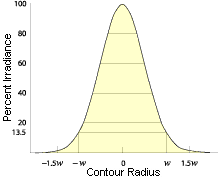 |
|
||||||
 |
Knowledge of Laser |
| Home > Knowledge Center > Knowledge of laser > M2 Factor (Quality Factor) |
Transverse modes have a field vector normal to the direction of propogation and are determined by the geometry of the laser or waveguide cavity and any limiting apertures. Waveguide modes are characterized as TE (transverse electric) with the electric vector normal, and TE (transverse magnetic) with the magnetic vector normal. In general, laser modes that do not have wall boundary conditions are designated TEM (transvers electric magnetic) with both vectors normal to the direction of propogation. The lowest order mode is the Gaussian TEM00. The appearance that higher-order modes take depends upon whether the limiting apertures are circular or rectancular. The three lowest-order modes for a circularly symmetric cavity are shown below In most laser applications it is necessary to focus, modify, or shape the laser beam by using lenses and other optical elements. In general, laser-beam propagation can be approximated by assuming that the laser beam has an ideal Gaussian intensity profile, corresponding to the theoretical TEM00 mode. Coherent Gaussian beams have peculiar transformation properties that require special consideration. In order to select the best optics for a particular laser application, it is important to understand the basic properties of Gaussian beams. Unfortunately, the output from real-life lasers is not truly Gaussian (although helium neon lasers and argon-ion lasers are a very close approximation). To accommodate this variance, a quality factor, M2 (called the “M-square” factor), has been defined to describe the deviation of the laser beam from a theoretical Gaussian. For a theoretical Gaussian, M2=1; for a real laser beam, M2>1. Helium neon lasers typically have an M2 factor that is less than 1.1. For ion lasers, the M2 factor is typically between 1.1 and 1.3. Collimated TEM00 diode laser beams usually have an M2 ranging from 1.1 to 1.7. For high-energy multimode lasers, the M2 factor can be as high as 3 or 4. In all cases, the M2 factor, which varies significantly, affects the characteristics of a laser beam and cannot be neglected in optical designs. In TEM00 mode, the beam emitted from a laser begins as a perfect plane wave with a Gaussian transverse irradiance profile as shown in the figure below. The Gaussian shape is truncated at some diameter either by the internal dimensions of the laser or by some limiting aperture in the optical train. The commonly adopted definition is the diameter at which the beam irradiance (intensity) has fallen to 1/e2 (13.5%) of its peak, or axial, value.
|
||||||||||
